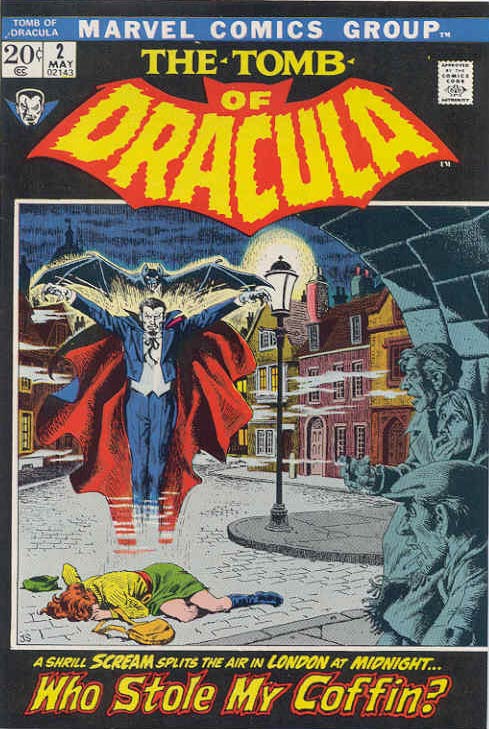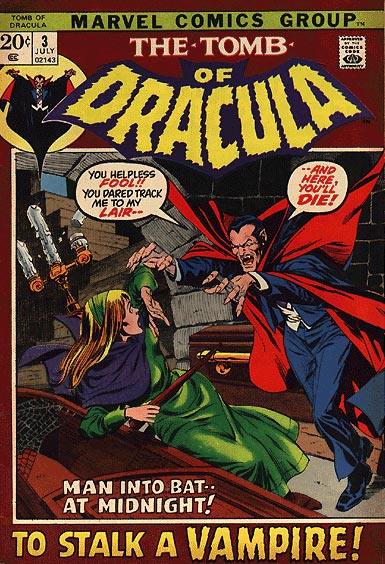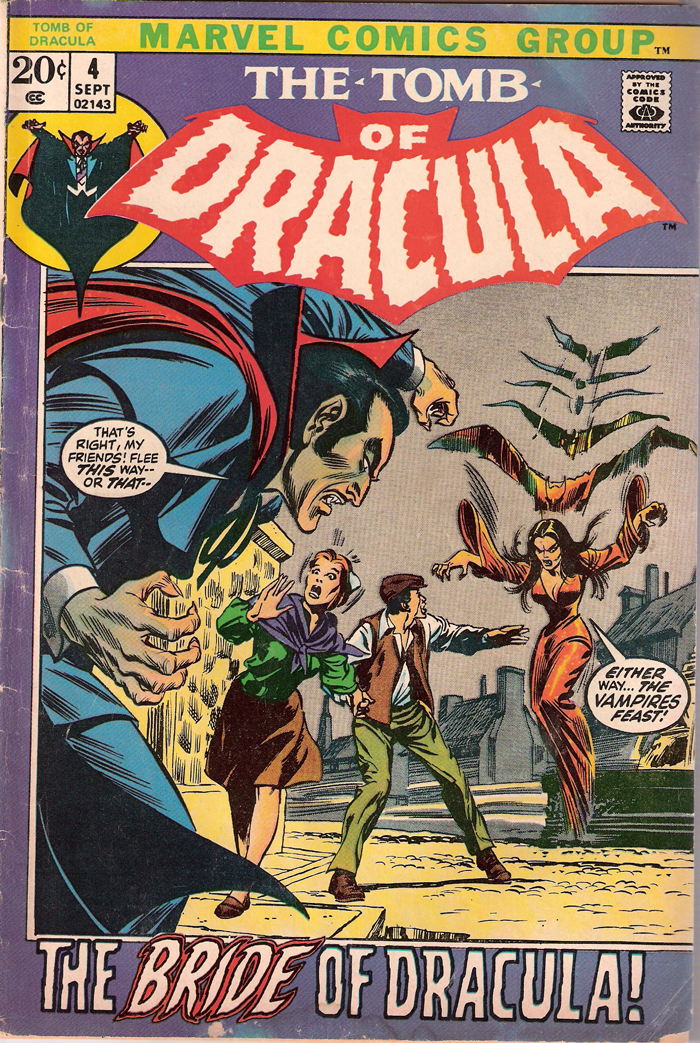Blogging Marvel’s The Tomb of Dracula, Part One

 Marvel’s The Tomb of Dracula is beyond question the finest horror comic series ever produced – a fact made all the more amazing when one considers that since the original series ended, none of the many revivals (even those with the original’s classic creative team) have succeeded in bottling lightning a second time. Much of the success of the book is down to the surprisingly literate scripts by Marv Wolfman and the stunning artwork by Gene Colan and inking by Tom Palmer. However, Wolfman did not come aboard until Issue 7 so this first installment in an ongoing series looking at this influential comic will focus on the first six issues of a title undergoing the pangs of development.
Marvel’s The Tomb of Dracula is beyond question the finest horror comic series ever produced – a fact made all the more amazing when one considers that since the original series ended, none of the many revivals (even those with the original’s classic creative team) have succeeded in bottling lightning a second time. Much of the success of the book is down to the surprisingly literate scripts by Marv Wolfman and the stunning artwork by Gene Colan and inking by Tom Palmer. However, Wolfman did not come aboard until Issue 7 so this first installment in an ongoing series looking at this influential comic will focus on the first six issues of a title undergoing the pangs of development.
Roy Thomas deserves the credit for bringing this series to life. It was Thomas who convinced Stan Lee that the loosening standards of the Comics Code Authority and renewed interest in the occult could make an ongoing horror comic featuring Bram Stoker’s infamous vampire count the runaway success of 1972. The Comics Code Authority came into being in the 1950s as a reaction against crime and horror comics as a result of the rather disturbed fantasies of Dr. Frederic Wertham. His 1954 study, Seduction of the Innocent imagined underage sex between Batman and Robin and convinced countless parents that juvenile delinquency was as much to blame on comic books as it was Rock ‘n’ Roll. The fact that Wertham’s book revealed more about himself than the actual content of comic books was lost on parents, whether over-protective or neglectful, who were quick to latch onto an excuse for why the post-war nuclear family was struggling. The result was the neutering of comic books for nearly twenty years and a ban on crime and horror as entertainment suitable for children.
Prior to The Tomb of Dracula, most comics companies would have turned the character into a misunderstood superhero. Marvel already had one of those with Morbius, the Living Vampire, but The Tomb of Dracula was determined to prove as revolutionary to Marvel as Roy Thomas and Barry Windsor-Smith’s adaptation of Robert E. Howard’s Conan the Barbarian. Both titles were far more adult and, at the outset anyway, far removed from Marvel’s established continuity. They were gambles that paid off in an era when Marvel deserved to call itself The House of Ideas.

 Gerry Conway was the initial writer on the series. He was paired, from the very start, with artist Gene Colan. Colan had distinguished himself on Marvel’s Doctor Strange where his unique style found its perfect expression in depicting the astral battlefields of the sorcerer supreme and his otherworldly (and inter-dimensional) opponents. There was darkness in Colan’s work that immediately lent itself to realizing a project like The Tomb of Dracula.
Gerry Conway was the initial writer on the series. He was paired, from the very start, with artist Gene Colan. Colan had distinguished himself on Marvel’s Doctor Strange where his unique style found its perfect expression in depicting the astral battlefields of the sorcerer supreme and his otherworldly (and inter-dimensional) opponents. There was darkness in Colan’s work that immediately lent itself to realizing a project like The Tomb of Dracula.
Conway set the tone for the series in the first two issues which introduced readers to Frank Drake, the unprepossessing protagonist about to learn a lesson that will change his life. Drake is a spoiled rich kid who squandered his inheritance. A descendant of the legendary Count Dracula, Drake comes to Transylvania with his girlfriend Jeanie and his sycophantic best friend, Clifton Graves on a scheme to turn Castle Dracula into a tourist attraction. Jeanie was Clifton’s girlfriend, but in the spirit of the times switched boyfriends without seemingly affecting the friendships. Of course, Clifton harbors a hidden resentment for Frank because of Jeanie and because of their class differences. Even without the dark and stormy night as a backdrop, you know the trio is doomed the second they arrive at Castle Dracula.
In short order, Clifton discovers Count Dracula’s coffin and removes the stake from the heart of his skeletal remains. The reanimated vampire quickly casts Clifton into a pit where his enemies were tortured in centuries past and then attacks Jeanie and is off to drain the villagers dry. The first issue ends with self-centered Frank Drake even more ruined than before, with his girlfriend a vampire, his former best friend having opened a Pandora’s Box that could consume the entire world. He is lost with no prospects for the future and an unbearably heavy burden on his shoulders. How he responds to that burden and deals with his guilt becomes the linchpin the series is built upon.
Conway’s second issue sees Frank and a mute villager, Gort (a nod to The Day the Earth Stood Still) venturing to the castle and rescuing Clifton from the torture pit. Dracula is still preying upon the villagers; including poor old Dr. Carl Von Harbou (named for Fritz Lang’s wife and writing partner, Thea Von Harbou whose own triangle with Lang and his star, Rudolf Klein-Rogge mirrored the triangle of Frank, Jeanie, and Clifton). Love and lust make fools of men and Clifton’s lust for Jeanie nearly proves fatal. The level of violence throughout this second issue is startling, but Colan’s artwork is so stylish that it proves fascinating rather than disturbing. The issue ends with Jeanie laid to rest with a stake through the heart and disintegrated by the rising sun leaving poor pathetic Frank and Clifton to still contend with Dracula.

 Archie Goodwin took over the scripting duties for Issue 3. Tom Palmer began inking Gene Colan’s pencils with this issue and the look of the series had now achieved perfection. Goodwin introduces us to the capable Rachel Van Helsing (granddaughter of Abraham Van Helsing from the Stoker novel) and her mute companion, Taj Nital. Frank decides to throw in his lot with the professional vampire hunters to stop Dracula. Drake is no match, morally or physically, for Rachel and Taj but he is given a much-needed sense of direction. The issue also introduces as a supporting character, Inspector Chelm of Scotland Yard who is investigating the vampire murders. More importantly, Clfiton Graves switches sides and decides to become Dracula’s devoted slave. Rather late in the proceedings, we are introduced to Ilsa Strangways, an aging beauty obsessed with the occult, who welcomes Dracula into her home at the climax of the story.
Archie Goodwin took over the scripting duties for Issue 3. Tom Palmer began inking Gene Colan’s pencils with this issue and the look of the series had now achieved perfection. Goodwin introduces us to the capable Rachel Van Helsing (granddaughter of Abraham Van Helsing from the Stoker novel) and her mute companion, Taj Nital. Frank decides to throw in his lot with the professional vampire hunters to stop Dracula. Drake is no match, morally or physically, for Rachel and Taj but he is given a much-needed sense of direction. The issue also introduces as a supporting character, Inspector Chelm of Scotland Yard who is investigating the vampire murders. More importantly, Clfiton Graves switches sides and decides to become Dracula’s devoted slave. Rather late in the proceedings, we are introduced to Ilsa Strangways, an aging beauty obsessed with the occult, who welcomes Dracula into her home at the climax of the story.
Issue 4 sees Ilsa turned into a vampire (who very nearly attacks pathetic Clifton) before being dispatched by Rachel Van Helsing’s crossbow (a weapon borrowed from Universal’s first sequel to Dracula). The climax of this fast-paced issue sees Dracula locked in combat with Taj Nital when both of them plunge through Ilsa Strangways’ occult mirror which is a portal to another world. The lengthy flashbacks given to Ilsa are a nice mixture of Doctor Strange and H. P. Lovecraft’s Cthulhu Mythos and gives Gene Colan ample opportunity to work wonders with his artwork.
Gardner F. Fox, a veteran of the Golden Age of Comics, replaces Archie Goodwin as writer for the final two issues before Marv Wolfman comes aboard and steers the series to classic status. Fox’s storyline wanders quickly from Lovecraft territory to a time travel story with Dracula returning to 19th Century Transylvania to reunite with his vampire love, Lenore (an obvious nod to Edgar Allan Poe’s The Raven) and attempting to murder Abraham Van Helsing. Rachel saves her own grandfather’s life. Frank is finally able to step up and prove his mettle in this issue which ends with a nice cliffhanger with Dracula and Lenore exiting the portal and returning to the 20th Century leaving Frank, Rachel, and Taj trapped 100 years in the past.
Fox’s script for Issue 6 is more traditional fare with our heroes finding their own way out of the portal, reuniting with Inspector Chelm, hunting down Lenore (who Rachel dispatches with her ever-present crossbow) and being captured by Dracula who tosses Frank and Rachel into his cherished torture pit. An important character development in the issue is the two young people trapped in the pit finally declaring their love for one another and sharing their first kiss. They are rescued from the pit by the sasquatch-like Moorlands Monster that Inspector Chelm has been investigating. Fox reworks the Golden Age character, the Heap and gives him an update that would appeal to the Bigfoot-crazed early 1970s. The issue ends with Frank, Rachel, Taj, and their unlikely monstrous rescuer setting off to stop Dracula as the first six issue of this landmark series conclude. The revolving door of writers every two issues was about to end as Marvel was on the verge of completing the creative team to take the series forward and achieve its potential beginning with the seventh issue.
William Patrick Maynard was authorized to continue Sax Rohmer’s Fu Manchu thrillers beginning with The Terror of Fu Manchu (2009; Black Coat Press). A sequel, The Destiny of Fu Manchu is due for publication in December 2011. Also forthcoming is a collection of short stories featuring an original Edwardian detective, The Occult Case Book of Shankar Hardwicke and an original hardboiled detective novel, Lawhead. To see additional articles by William, visit his blog at SetiSays.blogspot.com
Excellent overview of the first few issues of Tomb of Dracula. I love the book; I think it’s one of the best things to come out of Marvel since Kirby left (along with Simonson’s Thor, Dematteis and Muth’s Moonshadow, and maybe Busiek and Ross’s Marvels). That said, the first few issues really only give you a hint of what’s to come, and do jump around a lot. Good job to sum them all up.
At least the art was strong from the start. Colan was the perfect guy for this book; not only did he have a solid grasp of comics storytelling, but he also combined realism with a sense of atmosphere like few artists before or since. If he drew a crumbling castle, you saw every stone — but also every shadow, and every tendril of mist snaking through the night, with the whole thing somehow composed so as to suggest even more. And, incredibly, the art got even better when Tom Palmer started inking him.
All that said … I suppose I have to quibble with the statement “beyond question the finest horror comic series ever produced.” I’m guessing ‘series’ here means ‘non-anthology series,’ which eliminates the EC books, but that still has to include Alan Moore’s Swamp Thing run, and arguably From Hell. Arguably Sandman, too, depending on where one comes down on ‘dark fantasy’ versus ‘horror’.
You could probably make a case for these assessments (especially if you consider From Hell more mainstream or historical fiction than horror), but it’s not beyond question. How about ‘beyond question the finest comics-code-approved series ever produced’?
Anyway, pedantry aside, I’m looking forward to more of these articles!
Thanks, Matthew. I agree with all points. As for taking exception with my admittedly sweeping statement that TOD was the finest horror comic series ever, please bear in mind it is just one man’s opinion and the hyperbole helps the piece rather than a more judicial “one of the best.” That said, it genuinely is my favorite horror comic of all time. Hope you enjoy the rest of the series.